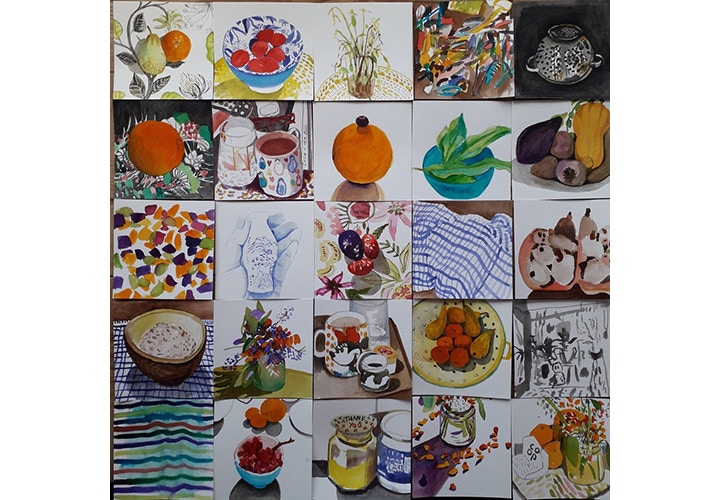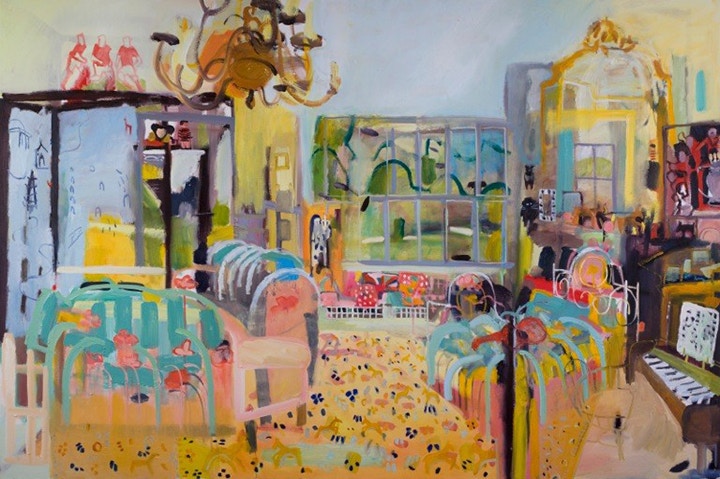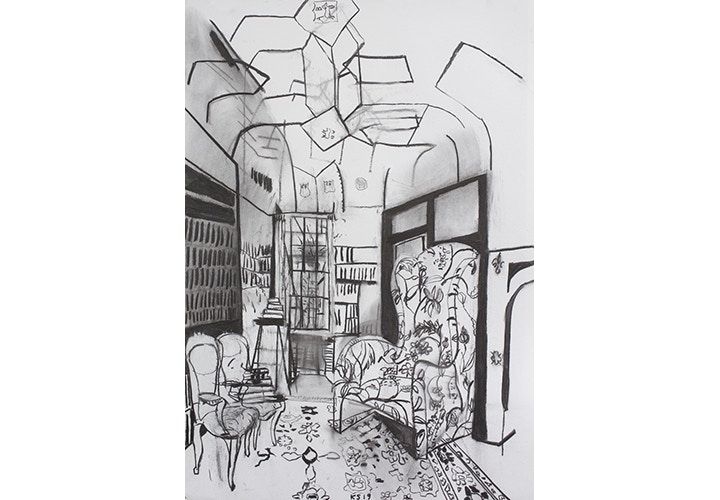Artist Interview: Winner of the Derwent Art Prize 2020, Katie Sollohub
Posted by Cass Art on 15th Jun 2020
The Derwent Art Prize aims to reward excellence by showcasing the very best 2D & 3D artworks created in pencil or coloured pencil as well as water soluble, pastel, graphite and charcoal by British and International artists. Derwent, internationally renowned fine art brand, are proud to announce that the fifth instalment of the Derwent Art Prize is now open online in the form of a virtual gallery
We caught up with this years winner Katie Sollohub to talk about her creative journey, her work and her experience of the prize this year!
Hi Kate - congratulations on winning the Derwent Art Prize 2020! Could you tell us a bit about your journey as an artist?
I studied Social Anthropology at University, but had always kept up my art since childhood, so it was seemingly inevitable that I would return to art school in my twenties. I did a Foundation and HND in Fine Art, both part time. From that point, I knew there was no turning back. I have been a practicing artist ever since. My practice always comes back to drawing, and painting, but has encompassed all sorts in between, including performance, writing, poetry and making installations. I see my creative practice as a way of engaging with the world, and it takes whatever form necessary. For a few years I was involved in a London based collective called the London Biennale, making fairly spontaneous, collaborative events all over the city and beyond. Nowadays I am based in my home studio in the garden in Shoreham By Sea, and have returned to drawing and painting as my first love. I have been lucky enough to receive funding for recent projects, invited to be artist in residence at Turner’s House in Twickenham in 2014/15. It was from this experience that the invitation to do some work at Strawberry Hill House came, where I made the prize winning drawing, The Blue Bedchamber. I call these excursions into other people’s homes my Roaming Residencies.
How have you found your experience of the prize? We’ve all had to adapt and find new ways of working and giving our creativity a platform during this time.
I have entered a few art prizes over the years, and am always very pleased to be shortlisted - which is by no means every time! It was very exciting to be selected for the Derwent, as it was my first time entering, and I was really looking forward to being part of the exhibition, both in London and Paris. I had no real idea of the actual prize money, it was enough to be shortlisted - when I found out I had been given first prize, I was absolutely stunned. Especially given the number of entries and the quality of the drawings.
-WEB.jpg)
Blue Bedchamber (Strawberry Hill House)
It was a unique experience exploring the Derwent prizewinning works in a virtual session! I hope that I’ll be able to enjoy seeing it in person in the not too distant future. I’d love to learn more about your winning work ‘The Blue Bedchamber (Strawberry Hill House) – what’s the story behind the piece?
I was first invited to draw in Strawberry Hill House after my residency at nearby Turner’s House, which ended with a solo exhibition at the Stables Gallery, Orleans House, in May 2016. I was delighted with the invitation, as I had never seen the inside of the house, despite having walked or driven past it on numerous occasions, on my way to Twickenham; it had always fascinated me.
There were so many rooms I loved, from the gold gilded red gallery and subtle light of the tribune, to the tiny wallpapered writing room at the top of the stairs. Each day I visited (and there were many, as all the work was done in situ), I would choose a different room to be in - following Walpole’s own daily motto “Fare que sentiat” (‘Do as you feel’).
On the day I drew the Blue Bedchamber, it was a warm, sunny day, the windows were fully open - they slide into the wall cavities, so there are no panes of glass or window frame to be seen - and the curtains around the bed were blowing in the wind. As I drew the outside, it seemed as if it was coming into the room, so I let it. In my drawing process, I usually let the line go for a walk, following the passage of my eyes, mapping the space. Charcoal is the most sensitive, immediate extension of my hand, responsive to touch, my drawing medium of choice. So my line can search and slide across the page, reaching into corners, weaving in and out of the spaces, crawl around the edges. I see the whole, as well as the details, as if my eyes are constantly coming in and out of focus. So too does the drawing. One minute clear, one minute lost in the process of looking. I choose to leave most of the traces of this exploration, removing only what seems insensitive, unnecessary, to the drawing. As the work evolves, my eye, and hand, might rest upon one area more than another. I remember becoming fascinated with the tailors dummy who stood hidden behind the open door - should I include her, or leave her out, what story would she have to tell. In the end she stayed, she inhabited the room, ghost like, in and out of the shadows, like the spirit of the wind. The open door to the right leads the eye out of the room, there always has to be a way out of my rooms. But it is dark through that door, so I am not sure I will be going there. Instead, I stay here in the light, the brilliance of colour, the fresh air of the window, the trees and blossom outside. This is how I draw, in situ, my hands following my eyes, following my imagination, making choices, creating spaces, and just enough of a narrative that those looking on might be tempted to step into the drawing too, and explore it for themselves.
In practical terms, I work on the floor, in situ, spreading out a dust sheet. I have to be there to feel the space, to look at it all around me. I work large, typically A1 or larger, so my whole body has to move in the process. As mentioned above, I use charcoal, I take a line for a walk, I let my hands follow my eyes, and let the drawing evolve. Most often I will rub out layers with a cotton rag, let the dust become part of the space, and draw again, changing viewpoints, shifting between space and detail, line and texture. I take pleasure in drawing the modern day plug socket in the skirting board, or shaping the elegant legs of the period chairs. Where shadows fall, I press harder with my hand, charcoal shapes spilling across the paper. I use a rubber to carve back into the grey, to draw the light back in, or create a feeling of lightness, of softness, in fabric or surface.
What is it about charcoal that you enjoy using as a medium?
Charcoal is for me the most tactile and immediate material to draw with. It responds to touch, to speed, weight and direction. It can be delicate, or dramatic, can be used for detail, or huge sweeping spatial gestures. It can involve the whole body in the process of drawing or be dangled from your fingertips. There is something very primal about charcoal - it would have been one of the first pigments used on the cave wall, the end of a burning stick. There is no need for any additional tools between you and the paper, just it, your hand, and the surface. It is very direct.

How does Turners Garden Grow
Part of your prize is a years worth of Derwent supplies! What are you most looking forward to trying?
As I love charcoal, I am really looking forward to trying out the coloured charcoal blocks - I have seen other people use them, but never had my own. There are similar blocks of coloured graphite, which I am also keen to try. I am hoping they will work in a similar way to charcoal, but with their own quality that I can learn about by experience. Also, the inktense blocks!
You also work with oil – I’d love to talk about your vivid colour palettes! How do you approach colour in your work?
People often ask about my use of colour. I find it hard to explain, as it is such an intuitive process for me. I love colour in everyday life, in my clothes, in patterns, in nature. When I paint, I might take inspiration from the colours I see in front of me, using observed colour as a reference point, but I never worry about getting the exact colour. A red floor becomes pink, a grey wall shifts into blue. I see colour as fluid, impermanent. Colours reflect colours, and change in light and shade. No colour is fixed. This is why painting is so much fun - you can start with any colour, and enjoy how it affects the blank space, and then the colours next to it. Colours can float on tip of other colours, they can dance and shimmer, or bleed and blend. Colour can be light or form, it can be detail, space, or mood. Colour is joyful, magical and mysterious. I can’t really explain how I use it, except that I experiment, play, and watch what happens. I start with a limited palette of primary colours, warm and cool, and see how many variations I can get from there. My palette is often as vibrant and alive as my painting, which is how it should be.

If I were to delve into your studio what materials am I likely to find? Do you have any particular brands you tend to turn to?
I have all sorts in my studio, as I tend to collect things over the years. Lots of scrap paper, lots of odds and ends. I enjoy mixed media for experimenting on paper, and have inks and pastels lying about. One of my favourite mixed media items is the Posca pen, liquid acrylic in a felt tip pen.
For my daily paintings, which I have been doing for a few years now, I use Anilinky watercolours - they make a great travel set, 4 discs that all join together in one block. I have an old pencil case with 2 brushes, a tiny water pot, and these. The paintings are all on 12 x 12cm watercolour paper.
My charcoal drawings are done with willow charcoal, usually Coates scene painters, nice thick pieces, and I use black chalk too. For oil painting I have been using Spectrum oils on the whole, having bought huge tubes a few years back. This is supplemented by inherited tubes from an old friend who left them to me. She liked Michael Harding, and Lukas. She had so many different tubes of red and orange! I have enjoyed using them in her memory, as well as Markel oil bars.
The surface is also important, what I draw and paint on - for drawing, I like everyday cartridge paper 220gsm, Fabriano smooth, as well as Arches cotton rag paper. They each have very different responses to charcoal, very rich. For painting, Arches also do an oil painting paper, but mostly I paint on canvas or linen, either cut to size, or ready stretched. I really love the colour of linen, and often work on linen sized with a see-through primer (Honsell Naturelle) so the colour is visible. If working very large, I have to buy a roll, or get them tailor made for me.

Dennis the Menace and the Red Ukelele
The literal approach you take to the titles of your paintings have an almost comical air. Is this relationship between directness and humour something that’s important to your work?
I like that you think that, that you noticed it. I had not thought deliberately to make things comical, but I do enjoy the titling of my work, somehow adding to the story without complicating things. I suppose my work is all about me being present in a space, a room, with some objects, to hold, to look at, to draw, to write about, to dream with (I often take a snooze in the space I am working in!). So my personal feelings, response, memory are a part of that whole process. I like to sit with my work and let it talk to me. I often write about my work, during and after it has been made. From here titles might emerge, or I sit down specially to talk to it, see what it has to say. I cannot title my work if I am not with it. Some of my favourite titles are “Dennis the Menace and the Red Ukulele” which was of a rather grand child’s bedroom; and “This is Where I shall Hide All My Treasures” which describes Horace Walpole’s Tribune in Strawberry Hill House. Sometimes the title comes as I am working on it. It becomes the essence of the piece. So yes, there is a directness, and often a humour, not just in the after thought of titling, but the whole way through. It is a story, about me being there: here I am, the artist is present, and this is what I saw….

Geraldine's Chair
Finally – what’s next on the horizon?
Winning the Derwent Prize has happened at just the right time for me, giving me the confidence to embrace being a full time artist, rather than splitting my time between my own practice and teaching. Lockdown has meant I have stopped all my classes, and have time and energy to focus on my work.
I am currently in 2 exhibitions - one has just opened as part of the Glyndebourne Opera Festival, which is now alas only online, now until 30 August 2020 at https://www.glyndebourneshop.com/art-gallery/katie-sollohub.html
In June I am showing new work along with 10 other artists in an exhibition called “Coming Together", all about working during Lockdown, at the Moncrieff Bray Gallery near Petworth 16 June - 4 July. Open by appointment only 10am - 5pm Tues - Sat (www.moncrieff-bray.com)
I am still working on ongoing projects in my studio. “Immersed” is all about the swimmers I meet with daily, for all year round ocean dips, on nearby Shoreham Beach where I live. Another practice is a series of daily paintings all about the objects in my home. This I have done over several years, along with various writings and more dreamlike daily drawings.
When I am allowed to travel more, I hope to resume doing my Roaming Residencies, which are commission based projects, painting in other people’s homes by invitation. And finally, one day, to go to Russia, where my father was born, to visit Moscow and Saint Petersburg and let the culture and landscape inspire me. This year’s plans have been cancelled.
Feeling Inspired?
Shop online for everything you'll need. Don't forget to hashtag #cassart on social media to show us your creations.


